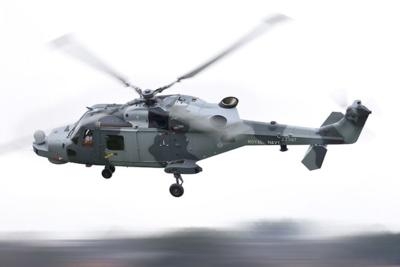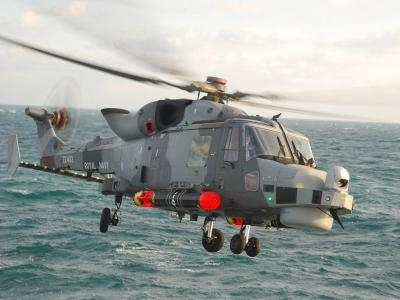Sun, Jul 14, 2013
New Helicopter Is 18 Months From Frontline Service
The U.K. Royal Navy's Five Fleet Air Arm pilots and observers are currently undergoing conversion training at the new Wildcat Training Center at Royal Naval Air Station (RNAS) Yeovilton, with the helicopter – successor to the Lynx – just 18 months away from front line service. From the beginning of 2015, Wildcats will begin to relieve the Lynx as the mainstay of helicopter operations for all of the Royal Navy’s Type 45 destroyers and some of its Type 23 frigates, as well as any other air missions the fleet requires of it.

700W – ‘W’ for Wildcat – Naval Air Squadron (700W NAS), based at RNAS Yeovilton in Somerset, got its first naval version of the new helicopter on 1 May 2013.
The squadron has been formed especially to bring Wildcat into front line service – squeezing every last ounce of information out of the helicopter so they can share it with the rest of the Wildcat world. Last month 700W NAS took the naval Wildcat to sea for the first time, carrying out deck landings on Royal Fleet Auxiliary vessel Mounts Bay off the south coast off England.
Its personnel – 5 pilots, 6 observers (who act as navigators/weapons systems specialists) and 44 ground crew and technicians – are also developing the tactics which will allow Wildcat to track drug-runners, intercept pirates, take out small surface targets, sink submarines and save lives in mid-ocean rescues; basically everything its predecessor Lynx does, only better.
“We often hear ‘it looks like a Lynx, how different can it be?’ Well yes, from the outside it bears a striking resemblance to the Lynx, but that really is where the similarity ends," said Wildcat pilot Lieutenant James Woods. "In Wildcat the Fleet Air Arm is getting a world-leading naval helicopter that builds upon the successes of the present-day Lynx. It’s bristling with the latest advanced mission systems and weapons – it’s the perfect solution to allow the Royal Navy to meet the challenges of tomorrow.”

The initial training was conducted by AgustaWestland. Now they’re passing on that experience to existing trained aircrews. And, from early 2015, the Fleet Air Arm will take rookie fliers straight from ‘helicopter school’ at RAF Shawbury and turn them into Wildcat pilots and crew.
The helicopter will take part in the Joint Warrior war games off Scotland for the first time this fall. The Fleet Air Arm is buying 28 Wildcats and the Army Air Corps is receiving 34. The maritime variant will be fitted with the SELEX Galileo Seaspray 7000E active electronically scanned array radar system for maritime surveillance missions. All will be based at Yeovilton.
The last Lynx will be withdrawn from service in the spring of 2017.
(Images provided by the U.K. MoD.)
More News
“Honored to accept this mission. Time to take over space. Let’s launch.” Source: SecTrans Sean Duffy commenting after President Donald Trump appointed U.S. Secret>[...]
Permanent Echo Radar signals reflected from fixed objects on the earth's surface; e.g., buildings, towers, terrain. Permanent echoes are distinguished from “ground clutter&rd>[...]
Aero Linx: European Hang Gliding and Paragliding Union (EHPU) The general aim of the EHPU is to promote and protect hang gliding and paragliding in Europe. In order to achieve this>[...]
Glider Encountered A Loss Of Lift And There Was Not Sufficient Altitude To Reach The Airport Analysis: The flight instructor reported that while turning final, the glider encounter>[...]
Airplane Climbed To 100 Ft Above Ground Level, At Which Time The Airplane Experienced A Total Loss Of Engine Power On May 24, 2025, at 1300 eastern daylight time, an Aeronca 7AC, N>[...]
 Aero-News: Quote of the Day (07.11.25)
Aero-News: Quote of the Day (07.11.25) ANN's Daily Aero-Term (07.11.25): Permanent Echo
ANN's Daily Aero-Term (07.11.25): Permanent Echo ANN's Daily Aero-Linx (07.11.25)
ANN's Daily Aero-Linx (07.11.25) NTSB Final Report: Schweizer SGS 2-33A
NTSB Final Report: Schweizer SGS 2-33A NTSB Prelim: Aeronca 7AC
NTSB Prelim: Aeronca 7AC




